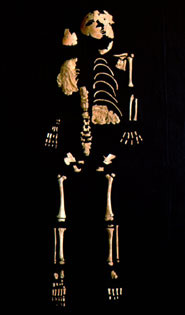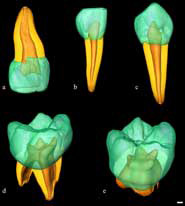
|  |  |  Health & Beauty Health & Beauty  
30,000-Year-Old Teeth Shed New Light on Human Evolution
 PNAS PNAS
go to original
January 08, 2010


| | The Lagar Velho skeleton | 
| | Virtual 3D reconstruction of four deciduous and one permanent teeth assessed for linear, surface, and volumetric tissue proportions |  |
The teeth of a 30,000-year-old child are shedding new light on the evolution of modern humans, thanks to research from the University of Bristol published this week in PNAS.

The teeth are part of the remarkably complete remains of a child found in the Abrigo do Lagar Velho, Portugal and excavated in 1998-9 under the leadership of Professor João Zilhão of the University of Bristol. Classified as a modern human with Neanderthal ancestry, the child raises controversial questions about how extensively Neanderthals and modern human groups of African descent interbred when they came into contact in Europe.

Early modern humans’, whose anatomy is basically similar to that of the human race today, emerged over 50,000 years ago and it has long been the common perception that little has changed in human biology since then.

When considering the biology of late archaic humans such as the Neanderthals, it is thus common to compare them with living humans and largely ignore the biology of the early modern humans who were close in time to the Neanderthals.

With this in mind, an international team, including Professor Zilhão, reanalysed the dentition of the Lagar Velho child (all of its deciduous – milk – teeth and almost all of its permanent teeth) to see how they compared to the teeth of Neanderthals, later Pleistocene (12,000-year-old) humans and modern humans.

Employing a technique called micro-tomography which uses x-rays to create cross-sections of 3D-objects, the researchers investigated the relative stages of formation of the developing teeth and the proportions of crown enamel, dentin and pulp in the teeth.

They found that, for a given stage of development of the cheek teeth, the front teeth were relatively delayed in their degree of formation. Moreover, the front teeth had a greater volume of dentin and pulp but proportionally less enamel than the teeth of recent humans.

The teeth of the Lagar Velho child thus fit the pattern evident in the preceding Neanderthals, and contrast with the teeth of later Pleistocene (12,000-year-old) humans and living modern humans.

Professor Zilhão said: “This new analysis of the Lagar Velho child joins a growing body of information from other early modern human fossils found across Europe (in Mladec in the Czech Republic, Pestera cu Oase and Pestera Muierii in Romania, and Les Rois in France) that shows these ‘early modern humans’ were ‘modern’ without being ‘fully modern’. Human anatomical evolution continued after they lived 30,000 to 40,000 years ago.”

The team was led by Priscilla Bayle (Muséum National d’Histoire Naturelle, France) and Roberto Macchiarelli (Université de Poitiers, France) and included Erik Trinkaus (Professor of Anthropology at Washington University, St.-Louis, Cidália Duarte (Câmara Municipal do Porto, Portugal), and Arnaud Mazurier (CRI-Biopôle-Poitiers, France).

Paper: Dental maturational sequence and dental tissue proportions in the early Upper Paleolithic child from Abrigo do Lagar Velho, Portugal by Priscilla Bayle, Roberto Macchiarelli, Erik Trinkaus, Cidália Duarte, Arnaud Mazurier, and João Zilhão. PNAS |

 |
|  |



